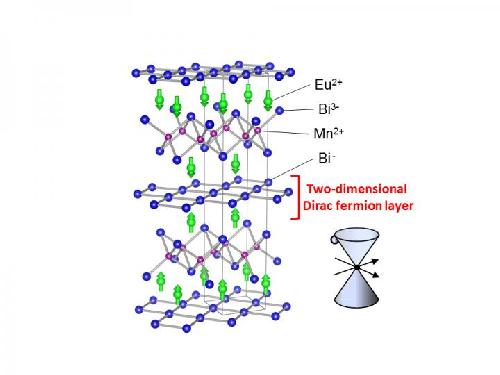A group of researchers from Osaka University and The University of Tokyo discovered a new magnet capable of controlling Dirac fermions with zero mass. This group's achievement will develop a new field of study, strong correlated quantum transport of Dirac electrons, and become an innovation in realizing super high speed spintronics, the foundation of high-speed and energy-saving electronics.
Hideaki Sakai (Associate Professor) at Osaka University and Shintaro Ishiwata (Associate Professor), Hidetoshi MASUDA (Graduate Student) at The University of Tokyo succeeded in the synthesis of high-quality single crystals of EuMnBi2, a layered compound which is thought to have both properties of Dirac fermions and magnets, using flux growth in a high vacuum. This material features hybrid architecture consisting of two-dimensional layers of bismuth with Dirac electrons and europium with magnetic properties.
In order to verify the strong correlation between Dirac fermions and the magnetic state, this group measured electric resistance in a strong magnetic field (some 30-60 tesla) at The Institute for Solid State Physics of The University of Tokyo and the High Field Laboratory for Superconducting Materials of Tohoku University.
 This is a schematic illustration of the lattice and magnetic structures for EuMnBi2 at zero field, together with the formal valence of each ion. The arrangement of the Mn sublattice is assumed to be the same as in SrMnBi2 Credit: Hideaki Sakai
This is a schematic illustration of the lattice and magnetic structures for EuMnBi2 at zero field, together with the formal valence of each ion. The arrangement of the Mn sublattice is assumed to be the same as in SrMnBi2 Credit: Hideaki Sakai
Furthermore, in order to elucidate the magnetic state, this group conducted magnetic scattering experiments using synchrotron x-rays at the Photon Factory of The Institute of Materials Structure Science, High Energy Accelerator Research Organization.
As a result, they found that electric resistance significantly changed depending on the magnetic order of europium. It was also found that when a magnetic field was applied perpendicularly to the two-dimensional Bi layers and the direction of magnetic moment was rotated by 90 degrees, the conductivity perpendicular to the layers was suppressed by 1000 percent and Dirac fermions were confined within each layer.
By confining Dirac electrons in the two-dimensional layer of Bi through the use of this effect, this joint group observed a bulk half-integer quantum Hall effect, in which the value of the Hall resistance becomes discrete, in a bulk magnet of Dirac fermions for the first time.
source: Osaka University